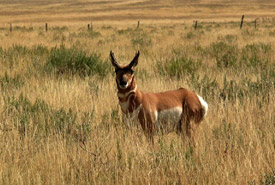
Pronghorn in Alberta (Photo courtesy of the University of Calgary)
Pronghorn
As the plains of Old Man on His Back Prairie and Heritage Conservation Area (OMB) in Saskatchewan glow deep copper, gold and saffron in the sunset, a sudden flash draws the eyes to something on the horizon. A herd of pronghorns has been startled. The flash of white from the hairs on their rump is a tell-tale warning sign to others of their kind.
Habitat and distribution
The pronghorn, the last wide-ranging native mammal on the North American prairies, is found nowhere else in the world. It has no other close relatives and bears no relationship to the African antelope. As the only remaining member of the family Antilocapra, Antilocapra americana is a truly unique member of the grasslands, steppes, foothills and deserts of North America, from Saskatchewan and Alberta south to Sonora, Baja California in Mexico.
In Canada, it lives on the western mixed- and short-grass prairies, although pronghorns were once found as far east as the edge of the tall grass prairie in Manitoba.
Diet
Pronghorns' primary diet consists of forage, browse plants and cacti.
Identification
Standing almost three feet tall at the shoulders, this small, fleet-footed hoofed mammal is the fastest land mammal in North America, reaching speeds of up to 100 kilometres an hour. In fact the pronghorn is the second-fastest mammal in the world, after the cheetah, which went extinct 12,000 years ago in North America.
The pronghorn gets its name for its horns, which consist of a bony core with a keratinous sheath that it sheds each year. In the males, the horns are pronged and can grow up to one foot in length, while in females they are rarely pronged and often not longer than their ears. Although both males and females share the characteristic reddish-brown or tan fur with a white stomach and chest, males are also distinguishable by the black markings on the lower jaw below the eye and a black mask on the muzzle.
When startled, the white hairs on the pronghorn's rump will stand erect to produce a flash of bright hair that is visible for many miles.
Threats
Pronghorns' ranges are often affected by fences barring their way. Although they refuse to jump over them, the animals may crawl under wire fences when there is room. Bands of migrating pronghorns are sometimes trapped by them.
What is NCC doing to protect habitat for this species?
By protecting large swaths of prairie habitat, such as the Old Man on His Back Prairie and Heritage Conservation Area, the Nature Conservancy of Canada (NCC) ensures that herds of pronghorns can continue to race and bound across the prairies.





